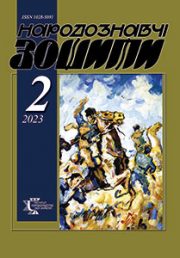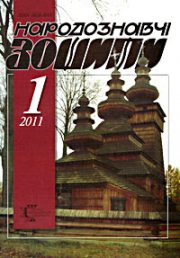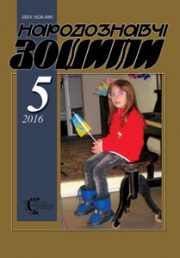The Ethnology Notebooks. 2019, 2 (146), 403—415
UDK 726.54-035.4:72.027.03(477.83)(092)
DOI https://doi.org/10.15407/nz2019.02.403
LUKA SNIGUR — LAST BUILDER OF THE BOYKO SCHOOL OF CHURCH ARCHITECTURE
TARAS Yaroslav
ORCID ID: https://orcid.org/0000-0001-7241-9466
Doctor of Historical Sciences, Professor
The Ethnology Institute
of the National Academy of Sciences of Ukraine,
Head of the Department of Ethnology,
15, Svobody Avenue, 79000, Lviv, Ukraine
Contacts: Е-mail: etnomod@ukr.net
Abstract. This article is devoted to the outstanding builder Luka Snigur, the last master of the Boyko School of Church Architecture.
The aim of the research is determined by the availability of new sources, which indicates that we have inaccuracies regarding the dates of birth, death, authorship of built churches. The purpose of this article is error correction in the L. Snigur’s biography, showing his formation as a master builder, disclosure of architectural and planning features of the churches built by Snigur, definition the measures necessary for the worthy commemoration of the 90th anniversary from the day of his death.
Documents certify that Luka Snigur was born on November 6, 1853 and died on June`20, 1929. It was established that the builder was a respected person, highly respected bythe Church, and communities of the surrounding villages.
Particular attention has been paid to clarify the authorship of churches. Scientific researches of M. Dragan, V. Sichinsky, P. Yurchenko, V. Vuytsik and V. Slobodian list many churches built by L. Snigur.
On the basis of this material and new sources, we submit a list of Luka Snigur’s churches, built, repaired and preserved to this day.
In addition, this article briefly substantiates Snigur’s formation and development process asa master-builder. It defines architectural and constructive decisions of the upper churchesroofs, Luka Snigur’s departure from the ancient models, which was influenced by professional architects. Therefore, it was determined two periods in his work. In the first period (1876 — the end of the XIX century), he continued to develop the architectural heritage of the XVIII-th — first half of the XIX-th century, in the second period (beginning of the XXth cc. — 1920s) he departed from the traditional Boyko School under the influence of modern solutions. It is also highlighted the construction of L. Snigur’s houses, peculiarities of solving portals, doors, and decision of corners. It has been established that L. Snigur’s churches, houses and public buildings have high artistic value. His buildings are characterized by the perfection of structures and the originality of architectural forms.
The celebrations were proposed in 2019, a yearof 90th anniversary from the day of his death.
On the basis of the research, the tasks were set: to make adjustments to L. Snigur’s biography and his creative work, to specify the place of his burial and install a monument on his grave and memorial plaques on the churches he built; to explore master’s creative work in the field of construction of public buildings, iconostases and carvings.
Keywords: Boykivshchyna, Luka Snigur, Boyko School of Church Architecture, master-builder, M. Dragan, V. Sichinsky, P. Yurchenko.
Received 12.02.2019
REFERENCES
Kolomyiky. (1969). Kiev: Naukova dumka [in Ukrainian].
Taranushenko, S.A. (2014). The Wooden Monumental Architecture of the Left-Bank Ukraine. The full edition. Kharkiv: Publisher Savchuk O.O. [in Ukrainian].
Yurchenko, P. (2007). Master Luke Snigur from Pohar. Sights of Ukraine: History and Culture, 3, 66—95 [in Ukrainian].
Dragan, M. (1937). Ukrainian Wooden churches (Ch. 1). Lviv [in Ukrainian].
Sichinsky, V. (1956). Architecture. In History of Ukrainian art (Vol. 1). New York: Naukove Tovarystvo im. Shevchenka v Amerytsi [in Ukrainian].
Kudrytskyj, A.V. (Ed.). (1992). Artists of Ukraine. Encyclopedic Handbook. Kiev [in Ukrainian].
Kudrytskyj, A.V. (Ed.). (1997). Art of Ukraine. Biographical guide. Kiev [in Ukrainian].
Pidkova, I.Z., & Shust, R.M. (Eds.). (1999). A guide to the history of Ukraine (Vol. 3). Kiev [in Ukrainian].
Ukrainian Soviet Encyclopedia. (1983). (Vol. 10). Kiev [in Ukrainian].
Kubijovych, V. (Ed.). (2000). Encyclopedia of Ukrainian Studies. Lviv [in Ukrainian].
Gordinsky, S. The artistic traditions of the Stryj region. In Strijshchina Historical and Memoirs collection (Vol. II). NY; Toronto; Paris; Sydney [in Ukrainian].
R№kowski, Grz. (2013). Ukrainian Carpathians and PreCarpathians (Western part). In Things to do. Sculptor of the Middle Ages in the Ukraine (Part V). REWASZ Publishing House [in Polish].
Yurchenko, P. (1968). Wooden architecture. In History of Ukrainian art (Vol. 3). Kiev [in Ukrainian].
Yurchenko, P. (1970). Wooden Architecture of Ukraine. Kiev: Budivelnyk [in Ukrainian].
Yurchenko, P. (1993). Master Luke Snigur from Pohar. Art, 3/4, 58—62 [in Ukrainian].
Wuyitsik V., & Slobodian, V. (2001). Materials to the dictionary of folk builders. In Notes of the Scientific Society named after Shevchenko (Vol. CCXLI: Works of the Architecture and Urban Development Commission). Lviv [in Ukrainian].
Mohitich, I. (2002). Architecture of wooden temples. Bulletin of the Institute Ukrzakhidproektrestavratsiya, 12, 8—29 [in Ukrainian].
TSDIA of Lviv. F. 201. Op. 4a. Issue 4216 [in Ukrainian].
Metrical Book of the Church of St. Dmitry village Pogar [in Ukrainian].
Book of church equipment village. Pogar [in Ukrainian].
Sichynskэ, V. (1940). Wooden buildings in the Carpathian region. Prague:







